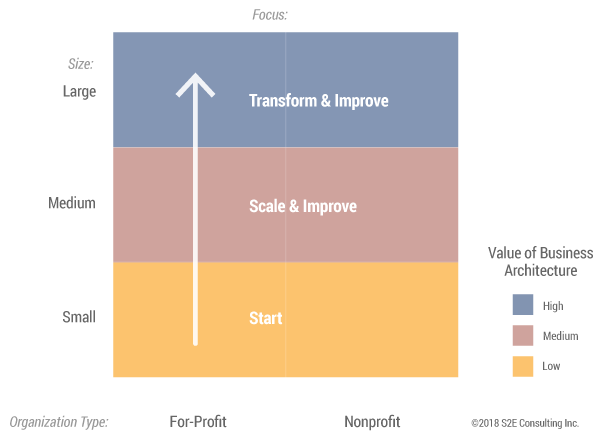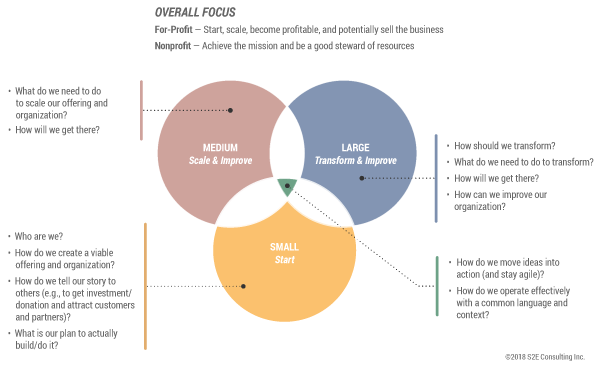B & EA EXECUTIVE UPDATE VOL. 21, NO. 7

Most business architecture efforts to date have focused on the discipline within a corporate and large organization context. However, business architecture is valuable to all organizations, regardless of type or size. This Executive Update discusses how nonprofits and small organizations can leverage business architecture and articulates some considerations for architecting within these types of environments.
Business Architecture Applies to All Organizations
One of the most frequently asked questions I hear is: does business architecture really apply to nonprofits or small organizations? The answer is yes. Business architecture can, should, and has been leveraged for for-profit organizations, government organizations, nonprofit organizations, social enterprises, faith-based organizations, and even cross-sector initiatives.
As Figure 1 shows, the need for and value of business architecture is more a function of organization size than of organization type. This is because as an organization grows, there is a greater need for a big-picture view and common language to help scale, transform, and execute strategy and other changes effectively and to operate with efficiency.

Benefits of Leveraging Business Architecture for Nonprofits and Small Organizations
To be successful, any organization needs: (1) a viable and competitive business model, (2) an intentionally designed organization, and (3) a way to set and execute direction. Business architecture is a critical enabler for all three. Unfortunately, most organizations do not begin creating and leveraging business architecture until they have reached a certain size and start to encounter challenges such as poor customer experience, complexity within the business and technology environment, or ineffective strategy execution. However, if organizations instead employed business architecture from the very beginning — even in a very lightweight manner — they could likely avoid these challenges as they scale.
For-profit and nonprofit organizations have different focuses and values. For example, as shown in Figure 2, for-profit organizations tend to focus on a lifecycle of starting up, scaling up, becoming profitable, and potentially selling the business. In contrast, nonprofit organizations may focus more on achieving their mission and being good stewards of resources, especially considering that those resources have been made possible by donors. However, as Figure 2 also illustrates, regardless of this focus, business architecture can help organizations as they start, scale, transform, and improve. For example:
-
Business architecture helps small organizations define a solid business model that will deliver a viable offering, design a well-structured organization able to scale, tell their story with confidence and demonstrate due diligence, and create an executable roadmap to build the organization and its offering, which leverages resources in the smartest way.
-
 Business architecture helps medium-sized organizations scale their offering and organization by identifying all business and technology impacts, designing a comprehensive vision of the future, and again creating an executable roadmap that leverages resources in the smartest way. Business architecture may also be used to demonstrate due diligence to build confidence among investors or donors for the scaling effort.
Business architecture helps medium-sized organizations scale their offering and organization by identifying all business and technology impacts, designing a comprehensive vision of the future, and again creating an executable roadmap that leverages resources in the smartest way. Business architecture may also be used to demonstrate due diligence to build confidence among investors or donors for the scaling effort. -
Business architecture helps large organizations transform when necessary through the same process of identifying impacts, designing a comprehensive vision of the future, and creating an executable roadmap. Business architecture can also be used for a wide variety of scenarios to support decision making (investments, strategic option selection, etc.) and improvement (simplification, business/IT architecture alignment, etc.), as is the focus of much of the current literature.
-
Business architecture helps all organizations move ideas into action and create end-to-end organizational agility by serving as the bridge between strategy and execution.1 In addition, it provides a foundational vocabulary and mental model about what the organization does that brings everyone together, regardless of role or geography.

Similarities and Differences: Business Architecture Within a Nonprofit and Small Organization Context
What Is the Same
The scope and principles of business architecture are exactly the same, regardless of an organization’s type or size. For example, the business architecture domains described within A Guide to the Business Architecture Body of Knowledge® (BIZBOK® Guide) — capabilities, value streams, organization, information, strategies, policies, products, stakeholders, initiatives, and metrics — all apply, as do their principles and the defined relationships between them.
Of course, the actual business architecture content (e.g., an organization’s specific capabilities or value streams) is different for every organization, and an organization may choose not to leverage all the available domains right away, especially if it is small or medium-sized.
What Is Different
On the other hand, the dynamics of applying business architecture within the context of a nonprofit or small organization can be quite different. For example, these organizations may do the following:
-
Deliver results quickly as time and resources are precious. Small organizations often have limited resources and must get their product to market quickly, while nonprofit organizations may not only have limited resources, but they may also have pressures to direct as much funding as possible on their programs (versus operational activities). As a result, business architects should do just enough business architecture, just in time, that provides immediate results. Business architects should also be prepared to apply other skills (e.g., strategy, general problem solving, and business analysis) outside of business architecture to fully solve the problem or opportunity at hand.
-
Introduce structured approaches over time. Small organizations may not be as accustomed to applying structured approaches, such as business architecture, or it may be that they just haven’t used them yet. As a result, business architects should focus on directly solving a problem or opportunity using business architecture and other relevant techniques. More context about the disciplines and techniques being applied can be shared over time as it becomes relevant.
-
Adapt to different worlds and languages. As mentioned in Figure 2, nonprofits are oriented around a different end game and values. They view the world a bit differently and use different terminology. As business architects with sharpened skills for abstraction, we may readily make connections between for-profit terminology like “customers” and “products” and nonprofit terminology like “beneficiaries” and “programs.” However, when working in a nonprofit organization, business architects need to adopt that organization’s language and fully put themselves within a new context. There are similar adaptations necessary for other contexts as well, such as when working with a true startup or a faith-based organization.
What It All Means
If you work in a large nonprofit organization, consider establishing a business architecture practice within your organization (or strengthening its role within your enterprise architecture team if necessary) to build your own capacity.2 As with any organization that is beginning a new practice, you will need to define the benefits to your organization and take small, deliberate steps to introduce and mature the discipline. There are also a growing number of business architects who are volunteering their talent to help nonprofits and small organizations, so you may be able to leverage some pro bono help along the way.
If you work in a small organization (nonprofit or for-profit), you can either build some business architecture capacity within the organization (e.g., one team member could serve as a part-time business architect in addition to his or her main role), or you can engage some external assistance. That assistance can be paid or, again, you may be able to leverage business architects willing to provide some pro bono help. If you do need to leverage paid help, you may be able to find it at a discounted rate. Investors in for-profit companies may also be open to funding this business architecture expense because it ultimately leads to a more successful and sustainable investment.
If you are a business architect who would like to share some of your time and talent to help a nonprofit or small organization, just do it. Whether you are an experienced practitioner or new to the discipline, you have something to give — and to learn.
As business architecture’s global footprint grows, it needs to be leveraged within all types and sizes of organizations. Otherwise, we leave behind a tremendous constituent of organizations that are important to our societies. What if business architecture could be leveraged in all organizations — how much more successful could they be as they start, scale, transform, and sustain? What if Architecting for Good™ (A4G) could become a movement of giving back, where people apply their “day job” talents to help others? How might our world be different?
1 For more information on how business architecture enables end-to-end strategy execution, see my Update “A New Vision for Strategy Execution.”
2 For more on how to start a business architecture practice within an organization, see my Update “Maturing a Business Architecture Practice: The Promise and the Path.”



